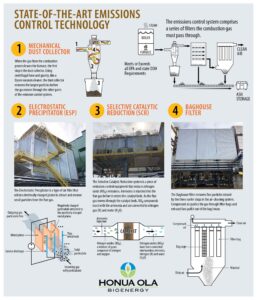FAQ
What is Honua Ola doing with the old Pepe‘ekeo power plant?
Honua Ola is refurbishing and refitting the old Hilo Coast Power Company plant into a modern renewable energy facility with a new steam turbine generator, state-of-the-art digital and emissions control equipment, sound dampening systems, and other efficiency and environmental improvements.
What kind of economic benefits will the plant bring to Hawai‘i Island?
More than 400 construction-related jobs were created during plant reconstruction which recommenced in mid 2017. About 30 permanent operations and maintenance workers have been hired in preparation for plant operations. Honua Ola will become the foundation for an innovative agriculture industry, creating more than 200 jobs in plant operations, forestry and transportation.
How will Honua Ola help the Hawaiʻi Island economy?
Hawai‘i Island residents will benefit financially with a homegrown energy source consistently available at a price not tied to the volatile fossil fuel market. Producing power with biomass is expected to lower the cost of electricity over time.
Energy Need
Why does Hawai‘i Island need biomass energy?
Honua Ola is the missing piece of the island’s renewable energy solution. The biomass-to-energy plant is important because it would provide a constant source of “firm” electricity and will complement intermittent sources like wind and solar. Honua Ola will produce power when the wind isn’t blowing and at night when the sun is not shining.
How much renewable power is Honua Ola capable of producing?
The Honua Ola plant has a contract with the electric utility to generate a net power output of up to 21.5 megwatts (MW), about 14 percent of Hawai‘i Island’s electrical needs, enough to power about 14,000 households. Honua Ola can be a stable source of power that would displace aging, oil-fired plants, eliminating about 250,000 barrels of imported foreign oil.
Feedstock
What feedstock will be used?
The primary feedstock will be eucalyptus, which grows in abundance on Hawaiʻi Islandʻs commercially managed forests. These forests were planted to foster a timber industry which was to be used for export. Because international market conditions have changed, these forests are now becoming overgrown and underutilized, and new uses such as biomass for energy repurposes it in a sustainable manner. More trees will be responsibly replanted when harvested to offset carbon emissions.
The biomass plant can use the whole tree or use portions left after logs are harvested for other uses including veneer and lumber components, thus enhancing the viability of the island’s timber industry. Other feedstock, such as invasive albizia and strawberry guava, can also be used, which will help the community rid of these dangerous and nuisance trees.
Environment
Will Honua Olaʻs power production be carbon neutral?
When we look at the entire Honua Ola power generation cycle, the power produced will be carbon neutral – no net carbon added to the environment. The carbon dioxide released by the plant will be offset by the continuous and sustainable growth of forestlands, which will capture an equivalent amount or more of carbon dioxide. In addition, with the displacement of existing fossil fuel plant generation (which Honua Ola is designed to replace), a significant reduction in carbon is expected.
Will Honua Ola conform to the air emission standards?
With existing technology, any form of firm power production creates emissions. Honua Olaʻs modern emissions controls meet or exceed current air emissions standards and comply with applicable Department of Health and EPA requirements. The plant is required by the federal and state agencies to meet stringent air quality requirements.
Will the facility contaminate and desalinate the brackish water aquifer?
No. All discharge will be non-hazardous and will meet State Water Quality Standards, so the environment will be protected from negative impacts. The salinity of water obtained from the brackish aquifer will be returned to the same brackish aquifer, and non-potable water that is purified will contain some low levels of salts such that there will be a negligible change in salinity.
Will the facility inject over two dozen hazardous chemicals into the wells?
No. In fact, the facility will only use seven water treatment products, at approximately four gallons total per day, to prevent scale and corrosion and to prevent deposits when water is converted to steam and back to water in the boiler. The composition of these products do not contain Clean Water Act listed chemicals above de minimis levels (1%).
Additionally, one non-hazardous product, at approximately 43 gallons per day, will be used to help control buildup of naturally occurring manganese from the supply wells and one other product will be used in the water purification system as an anti-scalant and softener to prevent calcium carbonate scale buildup. Again, both of these products do not contain Clean Water Act listed chemicals above de minimis levels.
In addition, such additives at 47 gallons per day of the 21.6 million gallons a day is de minimis by the EPA (less than 1% is considered de minimis).
Will the discharge be so hot that it will harm coral and marine life?
No. State Water Quality Standards (WQS) provide limitations that are considered protective of aquatic life. The EPA believes limits established to meet WQS are sufficient to satisfy Best Available Technology Economically Achievable (BAT) and Best Conventional Control Technology (BCT). Hawaiʻi Administrative Rules (HAR) 11-54-6 for marine waters states that temperature shall not vary by more than 1.0° Celsius (C) from ambient conditions. Based on a worst-case operating scenario, expert modeling shows that the temperature will be less than 1.0° Celsius from ambient.
Will the force of 21.6 MGD less than 100 feet from the edge of the cliffs cause further erosion and landslides?
No. Water will be returned to the brackish water aquifer below the mean sea water level, and not through the cliff face fronting the facility. Since the UIC wells are lined with stainless steel pipe for the first 120 feet or more, the water will reach a depth of some 40 feet or more below the sea water level, thus it is not possible for water to travel laterally above sea water level towards the cliff face.
Will drawing water from the brackish aquifer or non-potable aquifer deplete the water for the community?
No. The drawdown is limited to a small radius around the supply wells and will not affect community supply sources.
Why is Outfall No. 3 not included in Honua Olaʻs storm water application?
Stormwater from the site will not be directed to Outfall No. 3.
Why are manganese, copper and arsenic not included as pollutants?
These compounds are naturally occurring metals in nature and not pollutants associated with the industrial activities of the facility.
Is there highly toxic soil on site?
No. Phase 2 Environmental Site Assessment soil testing results of former sugar and coal operations showed the soil was below State human health risk levels.
Does the facility currently have an ash pile left abandoned by its predecessor coal plant?
No. The ash pile being referenced in public comments is erroneous. It is not on Honua Olaʻs site and is not considered highly toxic by the Department of Health.
Project Permits
Does Honua Ola have the permits required for operation?
Honua Ola was granted an air permit by the Department of Health, as well as an amendment to its Special Management Area (SMA) permit by the Hawai‘i County Windward Planning Commission. The process for approving both permits included public hearings, as well as a contested case hearing for the amendment to the SMA permit. These proceedings provided substantial opportunity for public comment.
Honua Ola is also in the process of obtaining an Underground Injection Control permit and an industrial activity storm water permit from the Hawaiʻi Department of Health. Honua Ola will also seek a solid waste permit from the Hawaiʻi Department of Health Solid Waste Branch to allow for the beneficial use of the wood ash.
Commitment to Community
Will the operation of Honua Ola negatively affect traffic and the surrounding roads?
A traffic study and survey by SSFM International found that the plant will have no significant traffic impact on Route 19.
There are residential areas surrounding Honua Ola. What does Honua Ola plan to do to be a good neighbor?
Although the plant is in an industrial zone, Honua Ola intends to remain a good neighbor to nearby residences. Honua Ola is committed to limiting biomass delivery trucks to daytime hours, and prohibiting loud engine braking or jake brakes on Sugar Mill Road.
Hawaii State Supreme Court (HSSC) Remand re: Life of the Land Lawsuit
What was the ruling by the HSSC?
On May 10, 2019, the Hawaii Supreme Court issued its decision regarding Life of the Land’s (LOL) appeal of the Public Utilities Commission’s (PUC) Decision and Order approving the Amended Power Purchase Agreement (Amended PPA) for the power plant. The Court found that the PUC did not explicitly consider the reduction of greenhouse gas (GHG) emissions in approving the Amended PPA as required by statute, HRS § 269-6(b). As a result, the Court remanded the matter to the PUC to carry out a contested case hearing on the Amended PPA. The Court said on remand, the PUC “shall give explicit consideration to the reduction of GHG emissions” in determining whether to approve the Amended PPA.
HELCO and Hu Honua are both working on a GHG emissions analysis to present to the PUC. HELCO had indicated that net GHG emissions with the Hu Honua plant would be reduced over 30 years as compared to without the Hu Honua plant. Hu Honua’s expert GHG consultant with global experience also intends to show how the Hu Honua plant would reduce net smokestack and lifecycle GHG emissions on Hawaii Island over 30 years as compared to without the Hu Honua plant.
What did the recent PUC order say with respect to GHG?
On June 20, 2019, the PUC issued an order re-opening the 2017 docket in which it approved the Amended PPA and requested updates on the Application, construction status, and permitting status. With respect to GHG, the PUC asked for an update on HELCO’s emissions analysis from 2017 regarding emissions from Hu Honua as compared to existing energy generation resources today, as compared to the recently-approved solar plus storage projects on Hawaii Island that are projected to be built by the end of 2022, and as compared to any new generation procured through the Phase 2 RFP (nothing has been procured yet and such projects are not expected to be completed until between 2022-2025). The PUC also asked for the Estimated Net Smokestack GHG Emissions Impact and the Estimated Net Lifecycle GHG Emissions, including emissions related to delivering biomass to the plant and emissions from constructing the plant.

